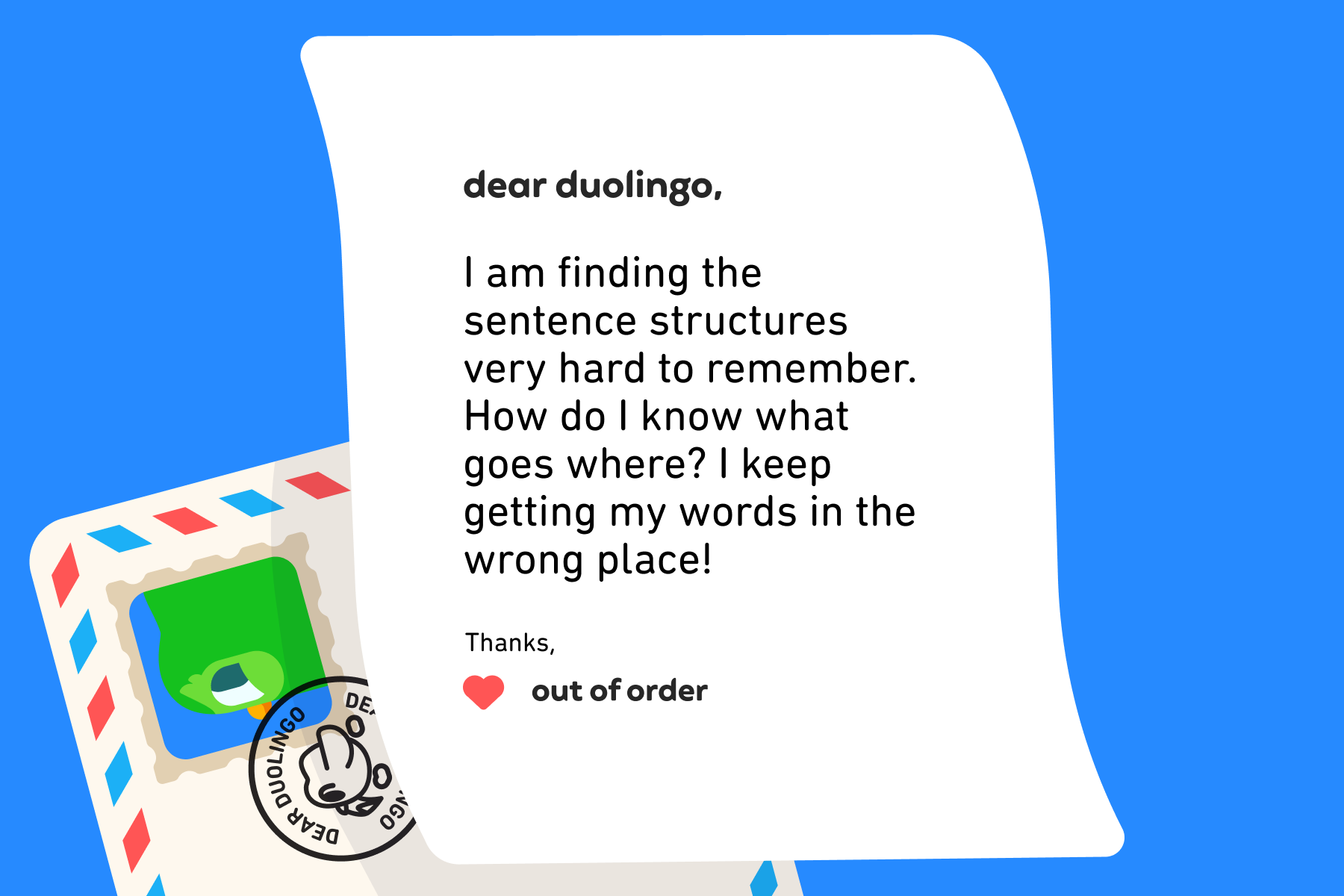Welcome to another week of Dear Duolingo, an advice column just for language learners. Catch up on past installments here.
Welcome back, learners! Today we've got a question especially for new learners, but I couldn't help but squeeze in some interesting linguistic factoids for learners of all levels. Can you remember feeling this way at the beginning of your learning journey?
Our question this week:

This is a really common feeling, Out of order! Especially when you're new to a language, it's easy to feel overwhelmed by all the words you're learning, rules about grammar and endings and word order, not to mention pronunciation, politeness—the list goes on! And especially at the start, it can feel hard to build up your own sentences from scratch.
What we're going to talk about today is called word order: the grammar rules that describe what order to put words in. Today we'll focus on the general rules for a few languages, and in a future post we'll talk about the rules for questions, negative sentences (like "I am not happy"), and more.
As you might have guessed, word order rules can be really different depending on the language! But naturally, there are some tricks to help. 🎉
How to put words together in your new language
What I used to recommend to my Spanish students was to think about sentences like a formula. You won't need this trick forever, or even for long, but it can be really helpful to get you comfortable building sentences. And with practice, soon you won't need the formulas anymore, and you'll be developing those instincts!
To start, we're going to think of sentences having three parts:
- Subjects. These are the words for the person, place, object, or idea that is doing some action (the verb).
- Verbs. This is the action of the sentence… sort of. "Action" is actually too exciting for many verbs, but it can be a helpful way to think of them. Something is doing something in your sentence, even if it's just being (and be is a verb!)
- Objects. These are also words for people, places, things, etc, but unlike subjects, these aren't the ones doing the action—they have a different relationship with the verb: Maybe they're the thing being given or acted upon, or they're receiving an action, benefiting from something, etc.
Some of those definitions are very, very squishy, so let's look at some example sentences from English:
| Subject | Verb | Object |
|---|---|---|
| You | cooked | |
| The team | won | the game |
| Cindy, the one who writes nerdy Dear Duolingo blog posts, | would have liked to have seen | more books about cross-linguistic word order |
| We, the residents of this building, | are writing | hand-written letters to be delivered by carrier pigeon expressing our support of lemonade stands |
So we can think of Subject + Verb + Object as a formula for English sentences! English sentences generally have this SVO (Subject + Verb + Object) word order, from short ones to long, complex ones. You can also see that objects aren't always necessary—not all verbs need them!
You can use this SVO formula for some other languages, too. It's the basic formula for many Romance languages, like Spanish and French.
I used to write the three SVO columns on the board in my classroom, and we'd fill them in together to practice creating sentences. You can try that, too! Here are a few simple sentence examples that use these three “slots.”
Spanish
| Subject | Verb | Object |
|---|---|---|
| Tú You |
dormiste slept |
|
| Los vecinos the neighbors |
comparten share |
la cosecha the harvest |
| Mis nuevos colegas y yo My new colleagues and I |
hemos leído have read |
cientos de correos electrónicos hundreds of emails |
French
| Subject | Verb | Object |
|---|---|---|
| Je I |
mange eat |
|
| La fille the girl |
lit reads |
le journal the newspaper |
| Il It |
faut vraiment arroser is truly necessary to water |
ces pauvres plantes qui sont en train de mourir these poor plants that are dying |
Word order around the world
But that SVO formula for sentences isn't the only possibility—and, around the world, it's not even the most common! In fact, Subject-Object-Verb (SOV) is the most common order around the world, and Object-Verb-Subject (OVS) and Object-Subject-Verb (OSV) are used only by a handful of languages for their basic order.
Here are some examples of languages with different basic word orders:
| Basic word order | Example languages |
|---|---|
| SVO | Chinese, English, French, Hebrew, Italian, Spanish, Vietnamese |
| SOV | Hindi, Japanese, Korean, Turkish |
| VSO | Modern Standard Arabic, Garifuna, Irish, Scottish Gaelic, Welsh |
| VOS | Kiribati, Malagasy, some languages of Malaysia (including Nias) |
| OVS | Very few! Ungarinjin in Australia and Tuvaluan in the Pacific |
| OSV | Very few! Kxoe in southern Africa and Nadëb in the Amazon |
Here are more examples from languages that you might be studying on Duolingo!
Irish and Celtic languages
Irish uses VSO as the default sentence formula. Here's how to say "The woman eats the sandwich":
| Verb | Subject | Object |
|---|---|---|
| Itheann eats |
an bhean the woman |
an ceapaire the sandwich |
German
German, on the other hand, doesn't neatly fall into one basic word order category and instead can have many different "basic" orders. One of German's basic formulas is SVO, like in English, but if the German sentence has a two-word verb (sort of like "I have seen the movie" in English), the verb gets split up. Here's how to say "I have the cup" and "I broke the cup" in German:
| Subject | Verb | Object |
|---|---|---|
| Ich I |
habe have |
die Tasse the cup |
| Subject | Verb | Object | Slot for two-part verb |
|---|---|---|---|
| Ich I |
habe have |
die Tasse the cup |
zerbrochen broken |
You can learn more about German word orders in this post from German expert Dr. Kristina Schoen!
Of course, in any new language you'll often want to say more than just a simple sentence! In a future post, we'll talk more about the other formulas you can use for questions, negative sentences, and more. (Who wants to talk about postpositions??) 🤩
Sentences are “made to order” 🍔
Using these formulas is a great way to get started building your first sentences, and soon enough making sentences on your own will feel like second nature! There's also more you can do with these word-order formulas, like looking for these patterns in the sentences you see in your Duolingo lessons. And soon we'll talk about the orders you'll need for other kinds of sentences, too!
If you've got a question about the language you're learning—or language in general!—send it to dearduolingo@duolingo.com.



